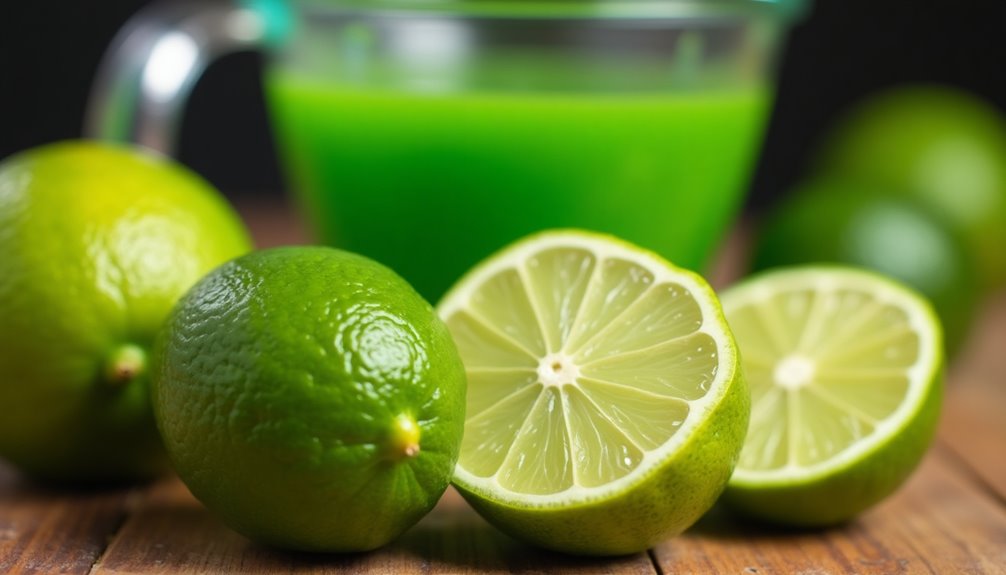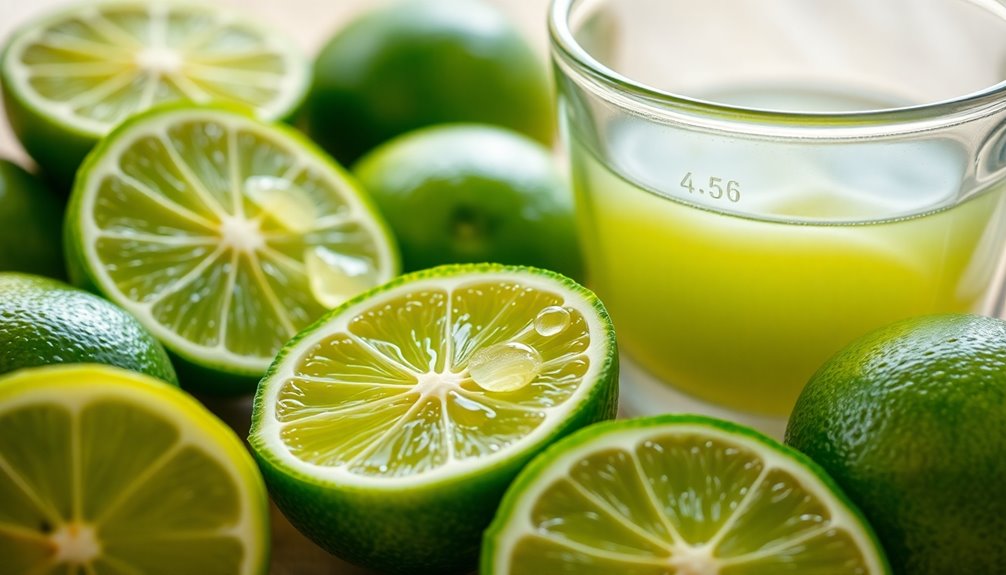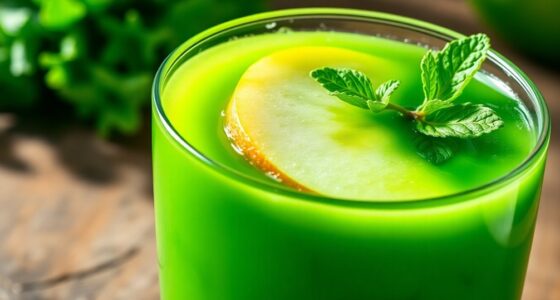To make a cup of juice, you'll need about eight medium-sized limes. Each lime typically gives you about 1 ounce of juice, which is roughly 2 tablespoons. If you have larger limes, you might need fewer to reach a full cup. Remember, the freshness of the limes can impact the flavor, so always choose the freshest ones. Curious about squeezing techniques or shopping tips? There's more to learn about maximizing your lime juice experience!
Key Takeaways
- About eight medium-sized limes are needed to yield one cup of juice.
- Each medium lime typically produces around 1 ounce of juice.
- Larger limes may require fewer than eight to reach one cup.
- A 1/4 cup of lime juice can be obtained from about two medium limes.
- Using a juicer or reamer can maximize juice extraction from each lime.

Have you ever wondered how many limes you need to squeeze for a cup of juice? It's a common question, especially if you're diving into recipes that call for fresh lime juice. The good news is that figuring it out isn't too complicated. Generally speaking, you'll need about eight medium-sized limes to get a full cup of that zesty goodness. Each medium lime typically yields around 1 ounce of juice, which translates to about 2 tablespoons. So, when you break it down, you can see how those limes add up.
If you've got larger limes on hand, you might find that you need fewer to reach that coveted cup of juice. Larger limes often have a higher juice yield, meaning you can get more fresh lime juice from each one. This can be especially handy if you're in the middle of a recipe and realize you're short on limes. Knowing that a 1/4 cup of lime juice can be squeezed from just about 2 medium limes helps when you're scaling recipes or planning meals.
When you're at the grocery store, it's a good idea to keep this juice yield in mind. Fresh lime juice truly enhances the flavor of a dish, and using the right amount of limes can make or break your recipe. Whether you're making a tangy marinade, a refreshing cocktail, or a zesty dessert, understanding how many limes to use can save you time and ensure your dishes are packed with that citrus punch.
You might also want to consider how you're squeezing those limes. Using a juicer or a reamer can maximize the amount of juice you extract. Just think about it: if you're getting every last drop of fresh juice from your limes, you're not only making the most of your ingredients, but you're also ensuring your recipes shine.
After all, nothing beats the vibrant flavor of fresh lime juice, especially when it's freshly squeezed.
Another tip? If you ever find yourself needing lime juice in a pinch and don't have fresh limes on hand, you can often find bottled lime juice in stores. However, keep in mind that it may lack the bright, fresh flavor of freshly squeezed juice. For the best results, aim to stick with fresh limes whenever possible.
Frequently Asked Questions
How Many Limes Do I Need for 1 Cup of Juice?
When you're preparing to make juice, knowing how many limes to use is crucial.
Generally, you'll need about 8 medium-sized limes to get enough juice for one cup. Each lime can yield around 2 tablespoons, so with 16 tablespoons needed for a cup, 8 limes will do the trick.
Keep in mind that the size and ripeness can affect the amount, so it's always good to have a few extra on hand!
Can I Substitute Bottled Lime Juice for Fresh Lime Juice?
You might be surprised to know that fresh lime juice is usually more potent than bottled, which means you'll often need to adjust the quantity.
Yes, you can substitute bottled lime juice for fresh, using a 1:1 ratio, but don't expect the same vibrant flavor.
For recipes where taste is crucial, fresh juice is the way to go.
If you're cooking, bottled might work, especially if you choose organic brands for better quality.
How Much Is Juice of 3 Limes?
If you're wondering how much juice you'll get from 3 limes, you're likely looking at about 6 tablespoons or 3 ounces of juice.
Keep in mind that this can vary based on the size and ripeness of the limes. If you're squeezing them for a recipe, it's a good idea to have an extra lime just in case you need more juice.
Fresh limes generally provide the best flavor!
How Many Key Limes Make a Cup of Juice?
If you're wondering how many key limes it takes to make a cup of juice, you'll need around 20.
Key limes are smaller and yield about 2 tablespoons of juice each, so you'll have to squeeze quite a few!
Their unique flavor and higher acidity make them perfect for recipes, but remember, if you're using larger Persian limes, you'll only need about 3 to get the same amount of juice.
Conclusion
In the garden of flavors, limes are the vibrant stars, each one bursting with potential. To craft a cup of juice, you'll need about 6 to 8 limes, their tangy essence harmonizing like a symphony. Just as a painter blends colors, you'll blend their juices to create a refreshing masterpiece. So, when life hands you limes, remember: it takes a handful to quench your thirst and illustrate the beauty of simple delights in every drop.
Cindy thoroughly researches juicing trends, techniques, and recipes to provide readers with practical advice and inspiration. Her writing style is accessible, engaging, and designed to make complex concepts easy to understand. Cindy’s dedication to promoting the advantages of juicing shines through her work, empowering readers to make positive changes in their lives through the simple act of juicing.











